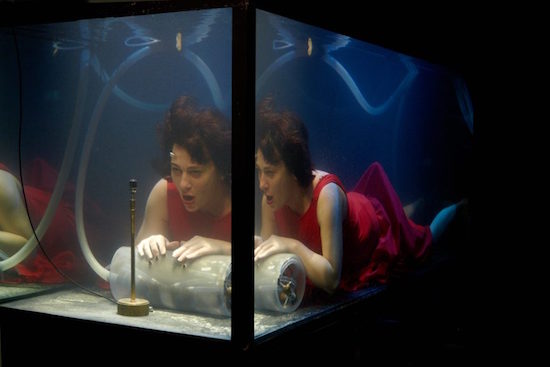In Glasgow’s Pollokshields district, two very distinct performances occur almost simultaneously. Both are concerned with water, either the presence or the absence of it. In the Tramway art space, five musicians dunked in giant aquariums are performing on a tenebrous stage. Four of them are using a combination of standard and curious instruments – hydraulophones, crystallophones, rotacordas, violins, percussion – while one manages to defy the laws of nature and is singing in remarkable, bubbling harmony with the surrounding celestial sounds. The performance, Aquasonic, is ostensibly from a group of Danish musicians but really could be from an infinitely more peculiar and distant time and place.
Meanwhile across the way at Govanhill Baths – Glasgow’s last surviving Edwardian public bath-house – an empty swimming pool is the setting for Kathy Hinde’s sculptural sound installation, Phase Transition. Tectonically deep bass frequencies emerge from slowed-down turntables, filling the empty space with near-physical soundwaves which bounce and reverberate as you move about the tiled bottom of the swimming pool.
This calibration of music, science, technology and often outrageous ambition is a hallmark of Sonica. The festival gleefully seesaws between intoxicating, outlandish interdisciplinary performances and contemplative, subtly challenging artistic installations. Aquasonic is perhaps the ideal opening event for a festival of this sort; it’s rich in profundity but accessible – sometimes even humorous – in execution. The performance pivots on composer Laila Skovmand’s vocal technique, where she keeps an air bubble in her mouth and sings through it when submerged, rising to the top every minute or so to take in a breath and a new bubble. Skovmand also worked with sculptor, designer and Björk collaborator Andy Cavatorta to create entirely new instruments especially designed for underwater performance, where sound travels four times faster – seriously affecting any hopes of significant resonation. This led to the creation of the rotacorda, inspired by the hurdygurdy, whose six strings can be plucked like a guitar’s, and the crystallophone, a modified version of Benjamin Franklin’s glass harmonica, made up of bowls that are played with the fingers like singing bowls, creating a similar effect to a bow moving over a violin string in air. Aligned with the performers’ need to breathe functioning as its own sort of percussive element, the effect is startling and somewhat frightening; the musicians cannot see each other, let alone their own instruments in their individual aquariums, the surrounding water on stage laps and leaps of its own accord, as if taunting the performers into feats of heinous endurance.
But the music created assuages any impending panic. The melding of violin, Tibetan singing bowls and, in particular, the gently caressed rotacorda, glides out of the aquariums, as if a sepia-toned filter has been applied to this vast chamber music swelling up from the depths. Most impressive are the wondrous, modulating harmonies sculpted by Skovmand and her co-vocalist Nanna Bech which bisect any extraneous sound by stretching the limits of whale song out into infinity.
Aquasonic photo by Morten Thun
While Aquasonic is a quintessential Sonica festival piece, Kathy Hinde’s work is perhaps more emblematic of the festival in displaying a passionate indifference for simple, banal categorisation. Hinde’s work is full of intellectual heft and ecological concern without ever coming over as cold or inaccessible. Phase Transitions was the standout installation at this year’s Sonica festival; the arresting presentation of turntables and infrared lamps amid the starkness of the empty swimming pool required multiple viewings to fully comprehend the gravity of the piece. In Hinde’s opinion, the physicality is a key element of the work: “It’s a monotone sound engraved permanently onto vinyl spinning slowly, very gradually increasing in speed, rising in pitch, emitting an atmosphere of apprehension and foreboding. In sync with this increase in speed and pitch, an infrared lamp increases in brightness and heat, causing a body of ice to melt more quickly. The physical immersion in these soundwaves connects us to the increase in ice melt, by which I aim to draw attention to climate change, with the most pronounced evidence of global warming being evident in the dramatic reduction Arctic ice.” It works – quite magnificently so – creating an awareness of space and emptiness like nothing else at Sonica.
Hinde’s versatility was also on display as she presented a second work, Singularity, a collaboration with Norwegian video artist Solveig Settemsdal. Taking its cue from the hypothesis that artificial intelligence will abruptly trigger rampant technological growth, resulting in unfathomable changes to human civilisation, Settemsdal’s video centres upon a point appearing in a perceived void which slowly and deliberately expands before disappearing again into its original form. Created through suspending white ink in cubes of gelatin, the mutating lines and layers emerge in tandem with ‘extreme gravitational phenomena’; it’s like an amorphous rubik’s cube cloud struggling to resolve itself. With the added symbiosis of Hinde’s accompanying composition – originally scored for string quartet and a bespoke new instrument created from resonating metal tines salvaged from toy pianos – you get these unspeakably elegant and shimmering scintillas of fractal patterns and fluid strings hovering between liquid and matter.
Sonica’s string of disparate events may seem unruly, but such a curatorial policy ensures a certain amount of responsibility lies with the audience to make our own set of connections between the multitude of disciplines and experiences here. So, what connects Kathy Hinde and Beneath Music, the originators of Aquasonic? Both reflect a commitment to making the impossible plausible and the nebulous tangible. And both have created a challenging and dynamic mix of sonic invention which resonates far beyond the festival.


